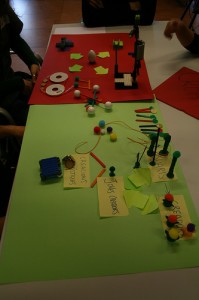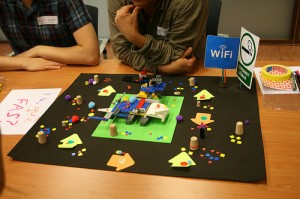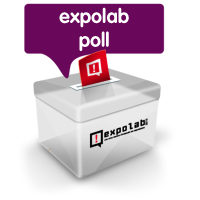On May 6th we made the third workshop on “Project 2.0. Practices for cultural institutions”, organized by the Centre for Contemporary Culture (CCCB) and the Citilab. This time it was Citilab, in Cornellà. Again, some thirty participants shared their knowledge and their desire to finish defining six groups of two to eight people. These groups worked on the creation of prototypes with cardboard, Lego, Plasticine … to finish defining a participatory project. Throughout the day, these prototypes were the seed that sparked great debate, which raised conflict, which led to consider some steps to take or to propose a reflection on the motivations for introducing citizen participation in the practices of cultural institutions our environment.
The structure was participatory, had the cooperation of all attendees, led to the co-design and strategies used … We could say that the workshop itself was itself an act 2.0 which also wanted to go beyond the 6 hours collective work, creating a working group on-line for further discussion and analysis of the hows, whys, whys who and participation.
The projects proposed by this group were the following:
Art at Home
 Bringing art home to democratize art and promote new artists.
Bringing art home to democratize art and promote new artists.- Self-managed platform for young artists, NGOs or Cooperative collectives, where you pay a registration fee. It is also contemplated that the artist can pay a service contracted out for the alternative to the fixed, or that the whole project can work as a cooperative or bank time.
- It will request for proposals for home interventions or artistic events.
- Platform acts as an intermediary and facilitator / channel of supply and demand for such services.
- Suitable for all types of art (music, theater, dance, performance, painting, video, etc).
- Can obtain feedback on the service request posted with a structure similar to Digg, in order to encourage word of mouth spreading.
- If offers the possibility of being able to involve the “public” actions / works, depending on the artist.
What are you doing?
 Project to encourage socialization. Open space to offer / propose cultural activities by citizens.
Project to encourage socialization. Open space to offer / propose cultural activities by citizens.- It is also an inspiration Center that aims at causing the reaction or mood change for users.
- Presence of music, painting, dance, facilities, computers, internet …
- It allows to work individually or with more people, “encouraged” by the theater.
- People come close to it, out of curiosity, making an artistic journey that leads them to a change of mind.
- It seeks a transformation of people into the spirit / creative way.
- It has an urban location, around a particular school or center of activities.
- It is proposed that it can be managed by a public-private consortium, or sponsored by a company as part of a code of corporate social responsibility.
- After interacting with the contents, citizens may propose new contents, which would led to activating new contacts.
- Eligibility to register / sign in person or via the web.
The philosophy of the project is to influence the citizen to make him/her think and change his/her roles.
People’s maps
 Geolocation platform to promote awareness among local people and to break distances between neighbours whether they are artists or not.
Geolocation platform to promote awareness among local people and to break distances between neighbours whether they are artists or not.- Easy interface that allows users to submit video and geolocate it in the city.
- Sewlfpromotion would help cultural and artistic offers but also social or business initiatives in the neighbourhodd.
- It also would have a synchronous communication layer via Skype or similar.
It would include voting systems to help assess content. - It allows the creation of routes to meet and get people togehter and relate them to upcoming initiatives.
- Mashup tool: Google maps API, content rating, Skype or similar.
- Would create a documentary archive of the city that would help in finding content of institutions or entities.
- It could also be extended in person or by means adhesives to QR codes that link the physical locations with digital map.
“Macba” 2.0
 Participatory refoundation of an existing museum to reflect the participation as of interest to contemporary society.
Participatory refoundation of an existing museum to reflect the participation as of interest to contemporary society.- It also tries to generate knowledge in a participatory manner and to reafirm its public nature and therefore this knowledge should be shared.
- Allows the aggregation of opinions, ideas, proposals about the institution and its activities.
- Promotes evolvving from an static to an emerging institution based on creative chaos.
- The user raises or “meddles” in the processes that defines the internal and external operation of the center.
Example proposals of initiatives and processes:
- Bonding with companies
- More user feedback> institution> artists
- Possibility of accommodating snacks and drinking in the exhibit spaces
- Allow the redesign of the exhibition spaces
- Possibility to use copyleft licenses on works
- Space for self-managed exhibitions
- Guided tours with the artists themselves
- Score on shows or complete works
- Database with keywords on each work
- Support to new artists and partnerships
- Playing space for adults and children
- It is open to gamers as a group with creative potential
- It generates financial resources to gain independence
- Open online presence to promote comment
- The essence is to turn the museum into an art center
“Who is an artist and who is not?”
 Virtual classroom project to generate debate on copyright.
Virtual classroom project to generate debate on copyright.- It starts from the distinction between “prosumers” and artists to compare their type of work and interventions.
- It puts into crisis the notion of authorship of artistic works.
Process:
• Generated / captured copyleft licensed works of artists
• It also on works created by the citizens themselves
• Many allowed formats: painting, sculpture, photography, video, etc.
• Works are exchanged bewteeen the “plain citizens” and the “artist” groups and each group works are given to the other group so that they can modify each other’s work in turns
• The results presented are virtual
• It also promotes reflection on the very concept of authorship.
• It raises the possibility that a third party could sell even with copyleft.
• The DJ as a metaphor for remixing and remaking content.
• The works can be changed both in person and online.
• It also promotes works that can go through different formats.
• It integrates the idea of holding regular meetings of intensive modification of the work.
The work is alive and in that sense never “completed”.
Technological Atheists
 It is a project that aims to promote active participation and critical debate around the fact of people being deciding whtehter to be always connected, or not.
It is a project that aims to promote active participation and critical debate around the fact of people being deciding whtehter to be always connected, or not.- A has a platform that allows to locate, view and connect with the “digital disconnected” people and their motivations for staying so.
- I will be done in both the most developed countries and in the less developed countries.
- It involves a trip around the world to detect cases in different places in terms of their cultural, political and economic diversity.
- A reporter with GPS information of Internet users keeps on locating people without Internet, cell phones or access to other Information Techologies.
- It uses a blog to report on steps taken to locate and interview the “disconnected person”.
- Each interviewee expresses what it means to be disconnected.
- The “public” on the other side (via internet) gives its opinion on whether that person should be connected or not.
- It aims to open the discussion to exchange opinions on the interest and / or need to “connect” to certain people.
- The project may end in a story or audiovisual product design.
- It could be sponsored by mobile phone companies or similar given that there would be extensive qualitative studies on the field.
If you want to see more photos from this event, you will find them in Flickr!
